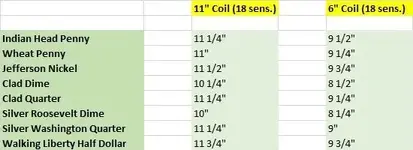- Joined
- Jan 11, 2011
- Messages
- 1,087
- Reaction score
- 1,398
- Golden Thread
- 0
- Location
- Norman, OK
- Detector(s) used
- Minelab Manticore, Minelab Equinox 800, Minelab Equinox 600, Minelab CTX 3030
- Primary Interest:
- Metal Detecting
- #1
Thread Owner
Hello all!
Based on requests from several folks who are curious, I went ahead and did some air testing with my new Minelab 6” coil, attached to my Equinox 800. I wanted to give folks some idea of the relative capabilities of this coil as compared to the 11” coil.
While all the normal caveats of air testing apply — such as, air-test results in no way mirror in-ground results, etc. etc. etc., I do think there is at least a little bit of value when doing side-by-side air testing of two different coils for comparison purposes. Anyway, how much value exists in such a test is up to each individual to decide; I simply wanted to provide the data. I also did a YouTube video, which I will post a link to as soon as it is done uploading. In the video, I did NOT record the testing of all the coins; I ran only the silver Roosevelt dime in the video to show you, audibly, what quality of signal I listened for in order to call it a “hit.” In other words, how repeatable of a signal I listened for before I assigned a depth value to that particular coin, with that particular coil. The rest of the video is just some discussion of a few points regarding the coil, and the testing.
Anyway, here is the data…
Minelab Equinox 800Based on requests from several folks who are curious, I went ahead and did some air testing with my new Minelab 6” coil, attached to my Equinox 800. I wanted to give folks some idea of the relative capabilities of this coil as compared to the 11” coil.
While all the normal caveats of air testing apply — such as, air-test results in no way mirror in-ground results, etc. etc. etc., I do think there is at least a little bit of value when doing side-by-side air testing of two different coils for comparison purposes. Anyway, how much value exists in such a test is up to each individual to decide; I simply wanted to provide the data. I also did a YouTube video, which I will post a link to as soon as it is done uploading. In the video, I did NOT record the testing of all the coins; I ran only the silver Roosevelt dime in the video to show you, audibly, what quality of signal I listened for in order to call it a “hit.” In other words, how repeatable of a signal I listened for before I assigned a depth value to that particular coin, with that particular coil. The rest of the video is just some discussion of a few points regarding the coil, and the testing.
Anyway, here is the data…
11” and 6” coils, air-test comparison, done indoors
Park 1 Mode
Sensitivity 18
Noise Cancel Channel 7
All-metal mode (horseshoe button engaged)
Ground Balance 0
Recovery Speed 4 (on the 800, equivalent to 2 on the 600)
Iron Bias 2 (on the 800, equivalent to 1 on the 600)
Here are the results:

After this “apples to apples” comparison, where I tested both coils using identical settings, I then re-tested a couple of coins (specifically the silver dime and the silver quarter) on the 6” coil, but this time bumping sensitivity to 22. I found that I was able to run sensitivity about 3 points higher, as the 6” coil is (as expected) less affected by EMI. Since “18” is a rather conservative sensitivity for a 6” coil (but that is as high as I could go with the 11” in my indoor testing, and I wanted to keep it “apples to apples”), I wanted to see how much depth gain I would get on the 6” coil if I bumped sensitivity up some.
Here are those results:

In summary, you can see that the 6” coil (at 18 sensitivity) loses roughly 1 ¾” depth on each coin, in an air test, as compared to the 11” coil. You can also see that by bumping the sensitivity on the 6” coil up from 18 to 22, you “gain back” most of the loss of air-test depth, getting to within ½” to ¾” of depths achieved by the 11”coil, set at 18 sensitivity. SO…while you DO lose depth with the 6” coil, as expected, you may — in a real-world scenario — be able to gain most of that depth back, due to being able to run it at a higher sensitivity setting. Overall, I am thus far impressed with the coil, and can’t wait to use it “in the field,” where I can begin to get a feel for its REAL value — its ability to separate, in trashy sites.
Steve
Last edited:




